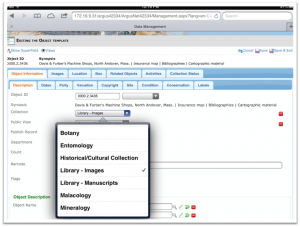Originally posted on SydneyPLUS blog 11/14/2014 - 12/03/2014
Following on from my blog post about the many benefits of special library marketing, I want to offer some ways to start thinking about marketing, and also to encourage you to consider developing a formal marketing plan for your library.
Before you start on any marketing activities it is important to have targets that you wish to reach through your marketing plan. In addition, you must know to whom you are marketing. After all, there is no point in directing your marketing initiative at your litigation department, if they are your main or only users. The idea is to attract and convert users who don’t currently see your library’s benefits.
Read More
Topics:
Library Management
Originally posted 10/27/2014 on Argus.net blogger
People love to uncover “hidden gems” and in the past, the Kalamazoo Valley Museum definitely fell into that category…it was “hidden.” Historically a hands-on family friendly place focused on educating and entertaining the local community, KVM’s new strategy includes showcasing their collection to virtual visitors around the world. Museums are knowledge repositories, and knowledge is most powerful when it’s shared. Aware of this, the founder of the Smithsonian Institution, James Smithson, stated he wanted to establish an institution "for the increase and diffusion of knowledge,” and today’s visionary museum leaders who continue in his footsteps are recognizing that technology is the key to that diffusion.
Read More
Topics:
Collections Management Software
I am often asked “what’s the secret sauce in Lucidea’s applications?” and further, I’m often asked why customers turn to our solutions rather than having IT build something in SharePoint or a SQL database.
I am also asked “what do I tell IT when they want to replace an existing Lucidea solution with one they promise to build in SharePoint?” Rather than discuss the many advantages of our Lucidea solutions, I’d like to share one simple but very powerful differentiator: date handling and date searching.
Read More
Topics:
Knowledge Management
Originally posted on SydneyPLUS blog 9/26/2014
In this second of two posts summarizing takeaways from this year’s ILTA SharePoint Symposium, I’ll focus on trends in cloud computing for SP users. “No doubt, cloud.” Microsoft’s cloud-first message for SharePoint and Office is clear. Although, “all in” is not a requirement – while new features will be delivered on Microsoft cloud platforms first, they are likely to be available via on-premise platforms second. *There was a loose Microsoft commitment to on -premise support, so we’ll have to wait and see.
Read More
Topics:
Library Management,
Knowledge Management
Originally posted on the SydneyPLUS blog 9/19/2014
At 2014’s ILTA SharePoint Symposium, solution providers and attendees were very focused on mobile and cloud computing. There are some interesting takeaways that I’d like to share. In this first of two blog posts, I’ll focus on trends in mobile and BYOD.
Read More
Topics:
Library Management,
Knowledge Management
Originally posted on Argus.net blogger 9/5/2014
Just recently the ubiquitous barcode turned 40. Yes, amazingly it has been 40 years since retailers started scanning products at the grocery store till. At this point you might be asking: “How does this relate to museums?”
Read More
Topics:
Collections Management Software
Originally posted on SydneyPLUS blog 8/21/2014
Visitors to your library’s website have often formed an impression of it before they even see it, thanks to search engine “snippets.” You can exert some control over what these snippets contain...
Read More
Topics:
Library Management,
Knowledge Management
Originally posted 8/27/2014 on Imagic's blog
Faceted searching is becoming a standard for special libraries that want to help end users find relevant content quickly and easily. Not all library automation systems today offer faceted searching. If they do, it’s definitely a competitive advantage.
Read More
Topics:
Library Management,
Knowledge Management,
Collections Management Software
Originally posted on Inmagic blog 7/30/2014
The majority of firms that approach us are struggling with low intranet /portal user adoption. There are many factors that contribute to this problem, but “empty portal syndrome” can be overcome if administrators stay focused on some key success factors.
Read More
Topics:
Library Management,
Knowledge Management,
Collections Management Software
Originally posted 6/19/2014 on the Inmagic blog
A fully loaded service pack is now available for all clients running Inmagic® Presto 4.3, and is ready for download by Presto customers, from the Presto Knowledgebase.
Read More
Topics:
Knowledge Management
Originally posted on Inmagic blog 5/30/2014
The simple truth is, there are serious challenges to the long term sustainability of special libraries, many of which may threaten your future if you don’t act. These challenges include the need to:
- Stay relevant by leveraging and managing social tools
- Reach an increasingly mobile user base
- Integrate your library’s knowledge with an increasingly complex IT environment
- Do more in an environment of ever-shrinking budgets
- Avoid being made redundant by content providers who reach out to end users directly
Read More
Topics:
Library Management
Originally posted on SydneyPLUS blog 5/30/2014
Two information industry veterans walk into a bar. They both walk out. What do you think happened?
Read More
Originally posted on the Argus.net blogger 5/11/2014
As with all museums, your Collections Management Policy will stipulate (and provide guidelines for) regular inventories of your collection, whether they are annual 100% inventories of your entire collection or more frequent random samplings. The introduction of collection management software over the years has made the maintenance and retrieval of inventory information much easier.
Read More
Topics:
Collections Management Software
Originally posted on Argus.net blogger 3/13/2014
The role of collections management software has changed over the years. Originally, registrars used software to describe objects and collections. As software feature sets became more robust, and as other staff members began to use them, the role of collections management solutions changed, too. The products that are in use today continue to support the museum’s descriptive needs, and they also offer documentation capabilities that save time and resources with regard to the collections and the processes that are vital to maintaining them. All good! But what are museums doing with other critical content: the detailed conservation reports, the correspondence from donors, the documents related to provenance, and other vital documents that relate to the collection and museum operations as a whole?
Read More
Topics:
Collections Management Software
Originally posted 7/18/2013 on the Inmagic blog
SharePoint seems to be everywhere these days. Many customers have been told by their IT departments that their knowledge management repositories should or will be converted to SharePoint by IT. Many customers are resisting this request, but often find it difficult to make IT understand that SharePoint is not capable of performing some of the functions that are important for managing and organizing content.
Read More
Topics:
Knowledge Management
Originally posted 3/12/2013 on the SydneyPLUS and Inmagic blogs
“If only HP knew what HP knows, we would be three times more productive.” Lew Platt, CEO, Hewlett-Packard
A KM strategy may not actually achieve 3X productivity, but impact - whether it is measured in profits or even in lives saved - can be dramatic, with amazing results as shown by the examples below:
- A mountain rescue organization proactively communicates warnings of adverse conditions to equipment retailers, guides, the media and individual subscribers. Four novice climbers decide to stay home rather than risk death.
- A professional services firm repurposes prior work and increases their billings by 1% -- resulting in 10% increase in profitability.
- A software company reuses existing intellectual property to enter a new market segment. The lowered development costs result in a triple digit ROI.
Read More
Topics:
Library Management,
Knowledge Management














